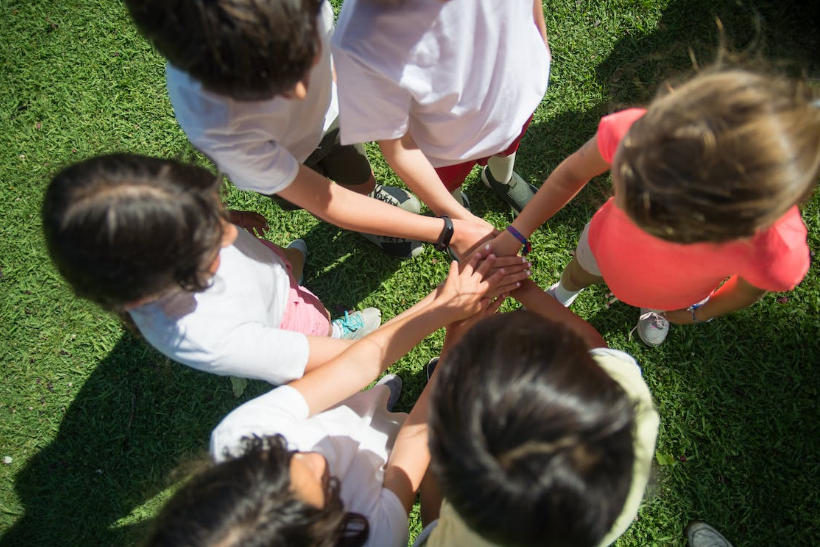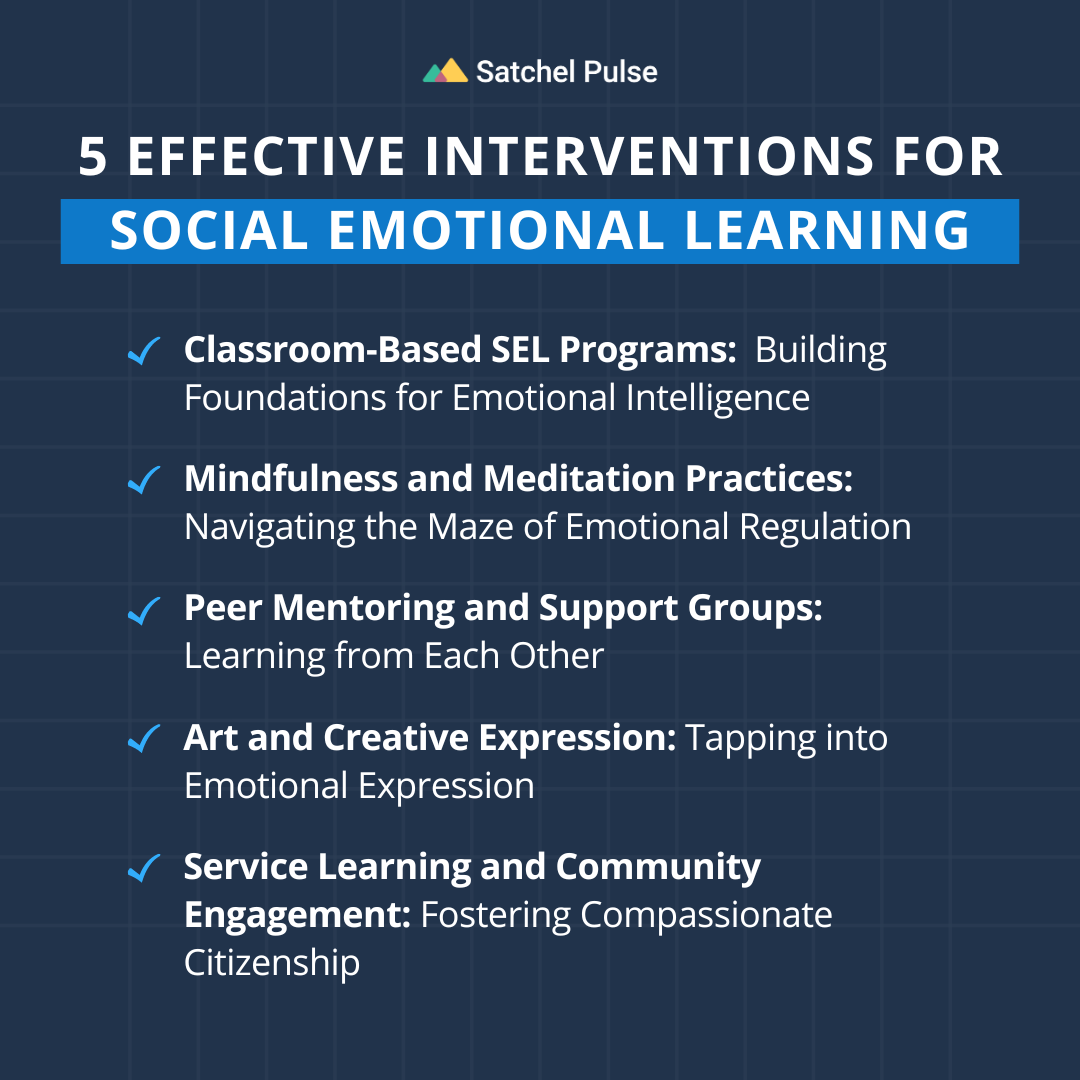Key takeaways
- Data-driven intervention plans ensure that individual's needs are met effectively
- Data from the assessments and interventions allow schools/districts to track progress and impact
- Assessments and data collection for all aspects of the curriculum support all students
Investing in Education: 5 Powerful Paths to Student Success
The return on investment in education doesn't always manifest in monetary terms. Imagine you had just $1 to invest in learning programs. Where would you place your bet? The answer might lie in Social Emotional Learning (SEL) programs, where your investment can yield lifelong dividends. But how do you get started? In this article, we will provide you with comprehensive, ready-to-implement SEL Interventions you can adopt starting tomorrow.
1. Classroom-Based SEL Programs: Building Foundations for Emotional Intelligence
Classroom-based SEL programs are the bedrock for integrating social emotional learning activities into the educational landscape. These programs offer structured, evidence-based SEL interventions seamlessly blending into everyday classroom activities. They focus on imparting a spectrum of skills to students, encompassing self-awareness, self-regulation, social awareness, relationship skills, and responsible decision-making.
Such programs align with the Collaborative for Academic, Social, and Emotional Learning (CASEL) framework. They empower educators with a structured approach to SEL, encouraging the creation of safe and inclusive classroom environments. Within these spaces, students can discuss their feelings, practice conflict resolution, and nurture empathy. Research has unequivocally demonstrated that schools embracing these programs witness improvements in academic performance, behavior, and overall well-being.

2. Mindfulness and Meditation Practices: Navigating the Maze of Emotional Regulation
Mindfulness and meditation practices have earned widespread recognition for their efficacy in improving emotional regulation and reducing stress. When introduced in schools, these practices encourage students to remain present, focus their attention, and become more attuned to their thoughts and feelings.
But before you envision a room filled with unruly students, take a moment to consider the transformative power of these activities. Here are some engaging techniques to impart mindfulness:
- Five Senses Grounding: Invite students to name five things they can see, four things they can touch, three things they can hear, two things they can smell, and one thing they can taste. This activity brings awareness to the present moment, engaging the senses.
- Guided Imagery: Lead students through a guided imagery exercise where they envision a peaceful place or scenario that induces happiness and relaxation. Encourage them to practice this independently and share their imaginary haven subsequently.
- Mindful Eating: Offer a small, simple snack (like a raisin or a piece of chocolate). Ask students to eat it mindfully, paying close attention to the taste, texture, and sensations as they chew slowly. This activity fosters mindful eating habits and cultivates a deeper appreciation for food.
These mindfulness and meditation activities can be tailored to suit students' age and maturity levels. Begin with shorter sessions, progressively increasing the duration as students grow more comfortable with these practices. These exercises facilitate the development of emotional resilience, anxiety reduction, and improved stress management - vital skills for navigating the complexities of both school and life.
3. Peer Mentoring and Support Groups: Learning from Each Other
Peer mentoring and support groups offer a unique SEL approach by tapping into the power of peer relationships. In these settings, mentor-mentee dynamics allow students to share feelings and experiences and gain insights from those who may better understand their perspectives.
Peer support groups are effective in addressing bullying and social isolation while also boosting self-esteem and improving social skills and emotional well-being among students.
Consider the following activities for implementing these interventions:
- Buddy System: Pair older students with younger counterparts to establish mentoring relationships.
- Peer Support Circles: Form small groups of students who meet regularly to discuss shared challenges and provide mutual support. Facilitate group discussions on bullying, stress management, or conflict resolution. Encourage students to share their experiences and offer peer support and advice.
- SEL Workshops Led by Peers: Train select students to become peer educators in SEL. These student educators conduct workshops and presentations on various SEL topics, sharing their knowledge and personal experiences with their peers. Potential workshop topics encompass Self-Esteem and Self-Confidence, Communication Skills, Digital Citizenship and Online Etiquette, Cultural Awareness and Inclusivity, Goal Setting, and Time Management.
- Conflict Resolution Mediation: Train students to act as peer mediators, equipping them to help resolve conflicts among their peers. When conflicts arise, peer mediators facilitate discussions and guide their peers toward peaceful resolutions. This approach empowers students to take responsibility for conflict resolution safely and constructively.
- SEL Storytelling Sessions: Host sessions where students or guest speakers share personal stories about SEL themes. These sessions enable participants to share their experiences, challenges, and personal growth journeys related to emotional intelligence and social skills. Potential themes include overcoming challenges, where students share stories of resilience and coping with stress, and emotional growth and self-awareness, where students reflect on moments when they became more aware of their emotions and how this awareness influenced their actions.
Engaging in these activities promotes peer support and mentoring while empowering students to contribute to a positive and emotionally supportive school environment. They offer valuable opportunities for students to develop important social and emotional learning (SEL) skills, including empathy, communication, and relationship building
4. Art and Creative Expression: Tapping into Emotional Expression
Art and creative expression provide a powerful outlet for students to explore and express their emotions. Art-based interventions can take various forms, including visual arts, music, dance, and drama. Engaging in creative activities allows students to communicate their feelings nonverbally, fostering self-expression and self-discovery
Art-based school SEL Challenges can be a creative way to reinforce Social and Emotional Learning (SEL) principles
- Self-Awareness Self-Portraits: Students create self-portraits that reflect their self-awareness. Through self-portraits, they must reflect on their self-perceptions, inner thoughts, and emotions.
- Conflict Resolution Poster Contest: Organize a poster design contest about conflict resolution and peaceful problem-solving. Encourage students to design posters that convey the importance of effective communication, empathy, and compromise in resolving conflicts.
- Growth Mindset Art Gallery: Arrange an art gallery showcasing artwork related to a growth mindset. Invite students to submit art pieces representing resilience, learning from mistakes, and embracing challenges positively
- Social Skills Comic Strip Challenge: Task students with creating comic strips that highlight social skills and positive interactions. Students can illustrate scenarios where characters demonstrate effective communication, active listening, and cooperation.
The Art-Based SEL Interventions are designed to encourage students to express their creativity and discuss SEL concepts in an enjoyable and artsy manner. This program also fosters collaboration and teamwork among students, which is essential in developing interpersonal skills. Art-making is also therapeutic, allowing students to cope with stress and emotional difficulties in a healthy way.
Learn more: SEL Interventions
5. Service Learning and Community Engagement: Fostering Compassionate Citizenship
Service learning and community engagement initiatives promote empathy, social awareness, and a sense of responsibility among students. These programs encourage students to actively participate in community service projects, volunteering, and outreach activities. By giving back to the community, students gain a deeper understanding of social issues and the needs of others.
Engaging in service learning fosters a sense of purpose and empathy, helping students recognize their actions' impact on others' well-being. This not only enhances their emotional intelligence but also reinforces the importance of being active, compassionate citizens in their communities.
Here are some strategies to implement Service Learning and Community Engagement:
- Community Partnerships: Collaborate with local organizations, nonprofits, and community groups to identify community issues and service opportunities. Establish ongoing partnerships with these organizations to provide students with various community service options. This increases awareness of problems affecting their environment and fosters a sense of responsibility, belonging, and participation. Embed assessment within the project and engage students in improvement plans.
- Community Needs Assessment: Involve students in detecting and conducting a survey or needs assessment in the local community. Engage students and the school community in gathering data on community needs and challenges. Use the results to guide service initiatives and empower students to propose and lead service projects.
- Regular Service Days: Dedicate specific days or hours throughout the school year to community service. Plan regular service days where students volunteer together on various projects, such as cleaning up parks, organizing food collections, or visiting local nursing homes.
- Social Justice Advocacy: Encourage students to advocate for social justice issues. Introduce students to social justice topics and guide them in organizing awareness campaigns, content-writing initiatives, or advocacy efforts. It's important to encourage students from diverse and underrepresented backgrounds to speak up for their communities and to encourage all students to support their efforts.
By implementing these ideas, schools can create a dynamic service learning and community engagement program. This program fosters empathy and social awareness and instills responsibility and active citizenship in students.

Conclusion: Empowering the Future
Social and Emotional Learning is an integral part of education, going beyond academics to equip students with essential life skills. These five effective SEL interventions offer diverse approaches to fostering emotional intelligence and enhancing overall well-being.
When thoughtfully and consistently implemented, these interventions contribute to improved academic performance, reduced behavioral issues, and better student mental health outcomes. By investing in Social and Emotional Learning, we empower the next generation with the tools they need to succeed in school and life. This makes it a worthy endeavor for educators, parents, and communities, shaping a brighter future for all.
Call to action:
Ready to empower your students with essential life skills through SEL interventions? Start implementing social emotional learning activities right away and witness the transformative impact. Embrace evidence-based SEL interventions that foster emotional intelligence and enhance overall well-being, giving your students the freedom to thrive. Don't miss out on the opportunity to create a positive and inclusive learning environment, allowing them to seize life's opportunities and actively support their individual life plans. Just as Amartya Sen's capability approach emphasizes, a fulfilled life depends on the relationship between what a person does or is and what he/she can do. Take the first step towards better academic performance, reduce behavioral issues, and improve mental health outcomes. Invest in the future today with social emotional learning interventions!
Author: Paola Mileo
Posted: 09 Oct 2023
Estimated time to read: 7 mins